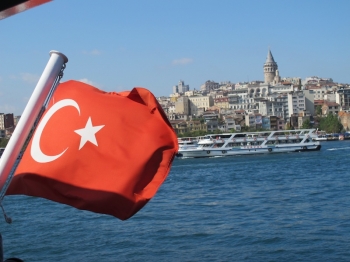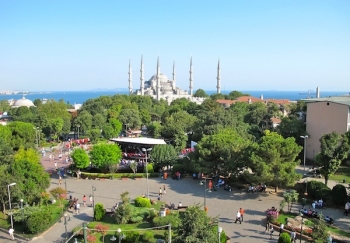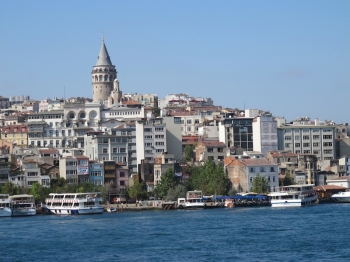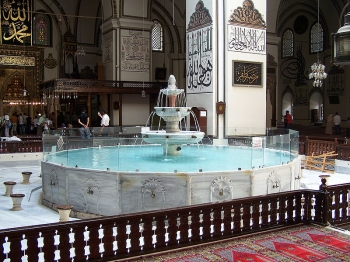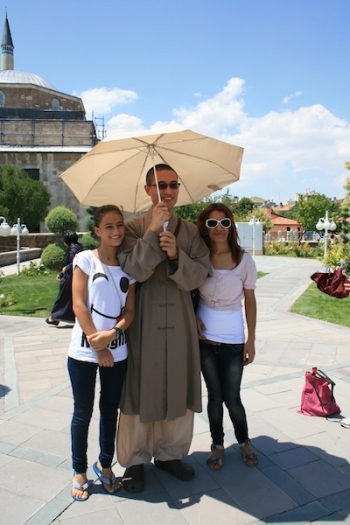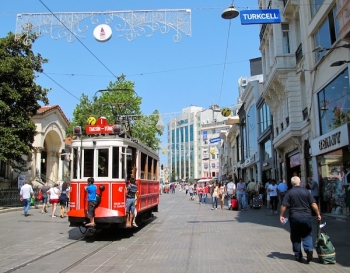Original Chinese text: Venerable Juetao
Translation: Isabelle Tsang
English editing: Cathy Ziengs
The Turkish summer sky is azure and cloudless. The sun shines intensely, although not in that way of scorching tropical sun that some of us know. Under the expansive sky, distant blue and green hues dance and flicker together, seducing the eyes, boldly declaring that there is a different blue in Turkey, a beautiful shade of turquoise.
The turquoise blue has an alluring appeal between blue and green. I think of Istanbul: the old historical town, once ruled by Roman, Byzantine, Ottoman and Turkic influence, a curious blend of east and west, culture and religion. More than 2000 years have left their traces of faded splendor and grand design. It is however like a precious jade stone that has been polished, the luster and warmth are even more captivating and worthy of careful savoring.
One afternoon we entered a mosque in Bursa with full carpeting and peaceful atmosphere. Sunlight penetrated through the domed ceiling and cascaded around the courtyard fountain below. Barefoot… the elderly, the young, all sat quietly reading scriptures on the podium, pausing with closed eyes or contemplative gazing into space. Enrobed in my monk’s gown amongst them, I did not feel at all out of place. Initially, we arrived as tourists: looking around, taking photos, moving about, click-click, snapping more shots… that energetic pace of visitors. Gradually, there was a magical pull… an invitation to partake in their doings, find a corner to sit down, relax… and take a breather in between time and space.
Before the trip to Turkey, my knowledge was extremely limited: ‘an Islamic country that geographically spanned Europe and Asia. It has mushroom-like stone pillars, white terrace-field shaped ponds, Turkish jade, Turkish baths’… and that was it… period. On this occasion I participated in the cultural exchange program sponsored by the Anatolia Cultural & Dialog Centre - the visit covered several cities in Turkey. We travelled in ferries, trains, buses and airplanes. Apart from the sightseeing and shopping, we also visited schools, organizations, shared meals with the locals, and this included one home stay. Obviously, it was not possible to visit and see all the important sites, scenery and unusual landscapes within the short 10 days. Although our guides provided plenty of historical and cultural information during the trip, upon return to Hong Kong, only a very muddled recollection was left in the mind. The Google search engine is a very useful tool indeed to fill the gaps.
However, what I would really like to say is this: even if the mosques and monuments in Turkey are so grand and magnificent; the scenery and landscape even more charming and breathtaking… the most lingering image in my mind is of the smiling and friendly faces. Those lasting memories of the people are what impress me most.
Our monastic robes (of monks and nuns in our group) made us stand out even amid our own group of Asian tourists from the east. When we walked around town, the majority of people would give us second glances, and many would take the initiative to greet us with a smile or request a photo with us. After chatting with a few, I suspected that in the bottom of their hearts, they thought that we spend most of our time practicing martial arts. We apologized in disappointment when they enthusiastically composed their kung-fu posture; only to shake our heads and admit that is not what we do. Buddhism is something that seems totally foreign to the majority of Turkish people. In their country with a dominant religion of 98% Muslims, the people, their friends and relatives, have been going to the mosque since young – devoted to reading scriptures and making prostrations. For many, it is probably their first encounter with a Buddhist monk or nun. However, they were generous with their friendliness. Because they were very happy, we were also felt happy.
What is it that makes people accustomed to labeling others… to stereotype? Is it because we are lazy to learn more about others? Is it ignorance, or anger that blinds us? It has been a long while since I have experienced that Shaolin Kung-Fu is perceived as a trademark of Chinese Buddhist monks. After 911, terrorist attacks became synonymous with Islam. Cathy from New York, one of our group members, has many feelings about that connection. She had personal encounters with the results of that catastrophe and the ensuring sorrow, fear and hatred. During the trip, we explored together an Islamic country opening her arms to the world. After this, how will we continue to label the Islamic religion?
When we speak of the Islamic religion, which aspect of Islamic religion are we referring to? As a rule we tend to oversimplify our understanding of certain people and events, to the extent of ignorance and settle for narrow definitions. There is a frequent tendency to exclude multiple factors and